By Emily Riippa | University Archives and Copper Country Historical Collections
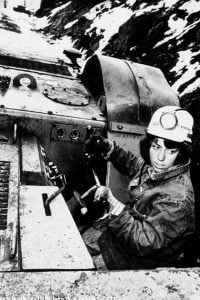
Huskies of yesterday and today will often mention “the ratio,” referring to the disproportionate number of male students compared to their female counterparts. According to the most recent statistics published by Undergraduate Admissions, women constitute some 28.2 percent of the Michigan Tech student body. This number may seem small, but it disguises a mighty tradition of accomplishment, innovation, and trailblazing. In honor of Women’s History Month, let’s take a whirlwind tour through how the lives of women at Tech have looked and changed over the years. Unfortunately, in such a small space as this, we can never do true justice to their stories!
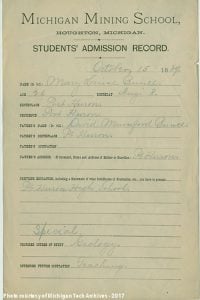
Just four years after the Michigan Mining School was founded, at a time when coeducation was uncommon, the first women enrolled. Both Margaret McElhinney and Mary Louise Bunce taught in the public schools of Houghton, and in 1889 they became students themselves again, taking classes in chemistry and geology on a part-time basis. The number of women enrolled remained small for many years, but their presence, once established, persisted. In 1933, Margaret Holley broke new ground for female Huskies by becoming the first woman to earn a bachelor’s degree from what was then called the Michigan College of Mining and Technology. Just a year later, she followed up her degree in general science with one in chemistry, then proceeded to a master’s program in general science again. So significant were Holley’s steps at Tech that she later served as a trustee and, under her married name of Margaret H. Chapman, helped to start a long-running scholarship fund in her name to support women’s education at Tech.
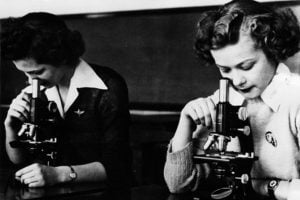
The year that Margaret Holley finished her first bachelor’s degree, Tech enrolled a record-breaking number of fourteen “co-eds,” the nickname given to female students at the time. World War II changed not only the number of women at Tech but also the nature of what the college permitted them to study. Historically, women had been admitted to programs in science and some facets of engineering; Ilmi Watia, for example, received a civil engineering degree in 1938. Tech discouraged women from enrolling in certain mining engineering courses and highly technical programs. With young men away at war in vast numbers, however, the United States and Tech both found a need for women to step into roles that they had not otherwise filled. In 1943, the college promoted a new war training program for women that started to break down some of these barriers. The courses were intended for “all young women who wish to serve their country in this emergency by training themselves for essential jobs that carry pay commensurate with their vital importance,” according to a marketing brochure. Women completing the program–whose length varied from eight weeks to a year, depending on the course of study chosen–could immediately enter government or industrial work in roles ranging from the more traditional secretary to engineering technician, full professional practitioner (if they already had degrees in other subjects), and airplane ferry pilot. All courses carried college credit, and women who did not find the curricula of the war training programs to their fancy were encouraged to pursue the full range of coursework at MCMT, including technical fields.
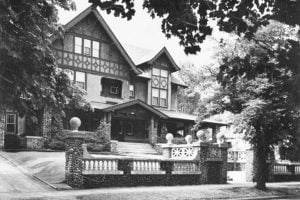
From there, slowly and steadily, the population of Tech women continued to grow and blaze trails. In 1945, a women’s dorm opened in the house formerly occupied by Kappa Delta Psi. In the years that followed, the former residence of the Fred Smith family was converted to women’s housing, and, at various times, female students also resided in houses known by the names of Pryor and Robinson. The first woman to earn a degree from Tech in metallurgical and materials engineering graduated in 1947; the first female mechanical engineer at the college finished her program in 1948. By 1952, the college had begun efforts to recruit women in earnest, publishing pamphlets explaining the scientific and mathematical careers open to them with a degree from Tech. Women answered the call and enrolled in many courses of study, including forestry, biological sciences, and all varieties of engineering. By 1968, 8.5 percent of Michigan Tech students were female, rendering the college officially coeducational by the metrics of the time. That year, Co-Ed Hall (now known as McNair) opened to alleviate a shortage of on-campus housing for women. A few years prior, Wadsworth Hall had begun to offer a few spaces to female students. Douglass Houghton Hall, on the other hand, remained all-male until 1973.
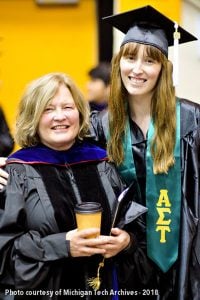
Women’s involvement and visibility on campus continued to grow through the remainder of the 20th century. In the 1970s, for example, the first female cadets joined the Air Force ROTC program, and the first national sorority and women’s teams in nordic and alpine skiing came to campus. From 1975 to 1982, Michigan Tech’s nursing program graduated nearly 300 hundred women, representing a larger proportion of female enrollment than perhaps any other degree program on campus. Groups like Woman Sphere and Tech Women’s Connection formed to advocate for women’s issues and initiated important dialogues in the Michigan Tech community. Meanwhile, in 1993, a team of Michigan Tech women won the Intercollegiate Mining Competition, demonstrating both their prowess at mining techniques and the college’s historic roots. How appropriate for Michigan Tech women to literally break ground.
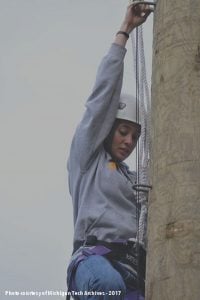
In 1969, Dean Harold Meese wrote to the women of Tech that, in spite of being vastly outnumbered by men on campus, “you traditionally have more than overcome these odds academically by earning better grade point averages. This, I feel, is due to your above average intelligence and your strong desire to become a well educated person and to find a meaningful way of life.” Whether they joined the Husky family in 1889, 1959, 1999, or 2019, women at Michigan Tech have always exemplified a passion for knowledge and a dedication to leaving their mark on the world. They are making history, one day at a time.
I spent nearly 3 years housed at DHH and based upon the single bathroom in each wing of the building, I find it unbelievable that women now stay in DHH. Do they live on separate floors as was the case at Wadsworth prior to CoEd Hall being built? Or did they reconfigue the bathrooms?
Jeff Dillon BSCE 1969
I started my studies at the Sault branch of Michigan Tech in 1952. I followed my brother
Robert Wellington there & both of us were proud to graduate from the Houghton campus.
Bob in 1954 and I in 1956. I was pretty naive & chose the Medical Technology field and
was happily employed in the medical field until retirement in 1999 @ age 65. I loved
competing with the boys when our classes brought us together. I haven’t been very
successful in connecting with any of the women that were @ Tech in the years 1953,1954,
and 1955 when I was on the Houghton campus. I’m writing this from the island of Maui
where I’ve spent the winter months since the year 2000. My home is in Anchorage, Ak.
The numbers on Co-Ed hall are only partly correct. East Co-Ed opened in the fall of 1968. West Co-Ed had opened some years before (I don’t know when). I moved into the top floor of the east wing as construction continued on the lower floors through fall term. I think only the top two floors were ready at the start of the term.
Kerry Irons, ’72
Groundbreaking for West Coed Hall (now McNair hall) occurred in December 1965; WCH opened in late Fall 1966. East Coed Hall began construction in 1966. Beautifully designed building and such a lovely view from the dining room!
More at this link —https://blogs.mtu.edu/alumni/2018/12/12/a-look-back-at-techs-residence-halls-or-dorms/#:~:text=Wadsworth%20Hall%2C%201971-,McNair%20Hall,Walter%20McNair%2C%20in%20December%201965.
I believe the first female forester enrolled in 1954, if memory serves, my senior year. I don’t know if she graduated but I do remember Forestry Head, Bert Noblet spending time with her explaining some of the less glamorous aspects of the profession to be sure she knew what she was getting into.
Beatrice Thornton of Hancock graduated from Michigan Tech circa 1947 Chemical Engineering. Went with her daughter . She was a part time Tech employee and my Quantative Analysis lab instructor. Me a 1970 graduate Chemical Engineering
I knew Mrs. Thornton and her husband Jim — they had a beautiful contemporary home in Hancock and a large Steinway piano in their living room (which they allowed some of us Toots to practice on). Very kind and caring folks.